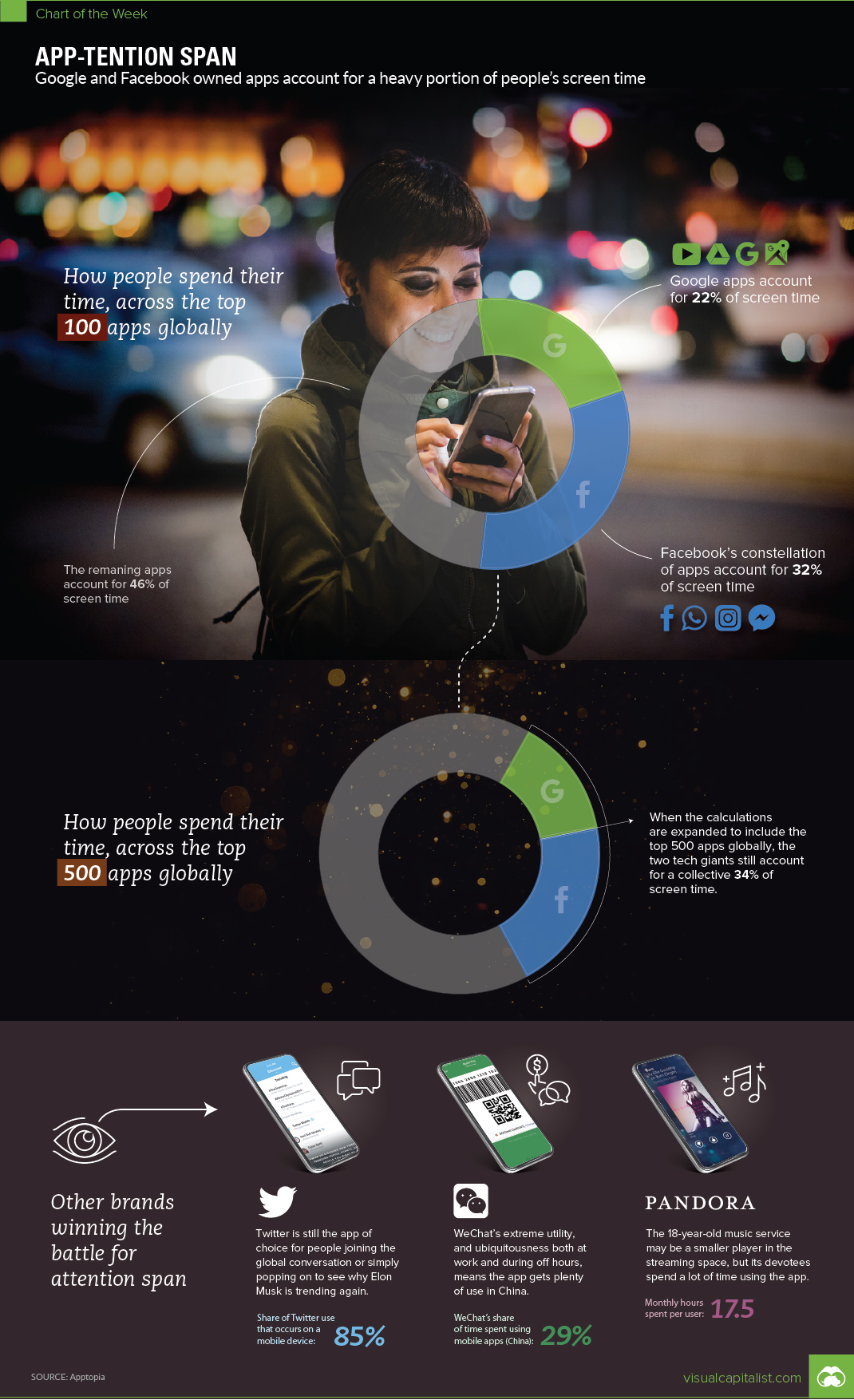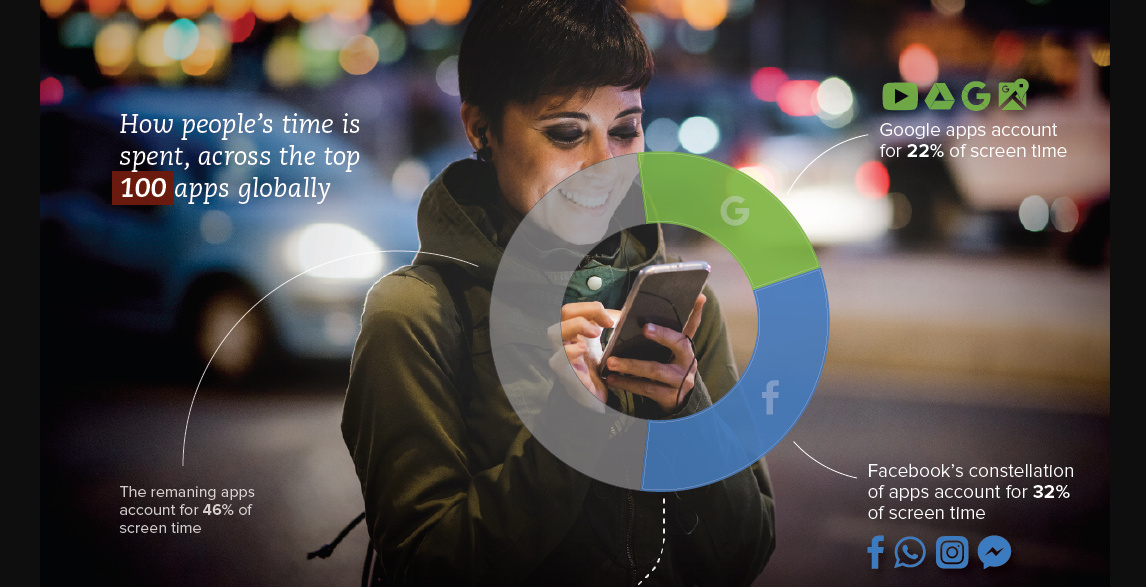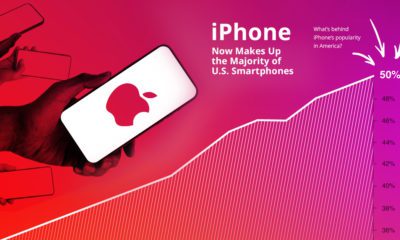The Apps Winning the Battle For Our Attention Span
With the smartphone as the centerpiece of the new global consumer economy, how we allocate our screentime between the myriad of apps that exist is becoming a very telling statistic. After all, the companies that win the battle for app mindshare will have unfettered access to billions of consumers, as well as the economic opportunities that emerge from that access.
The Duopoly vs. Everyone Else
Most know that Facebook and Google, the two tech giants that are lovingly referred to as “The Duopoly” by advertising executives, are already capturing $0.60 of every dollar spent on advertising online. And now, through acquisitions, The Duopoly is showing that they are able to stay ubiquitous as consumers spend even more time on their smartphones. According to recent data from Apptopia, the global app ecosystem is dominated by Facebook and Google owned apps. Together, among the top 100 apps, their products account for 54% of all screen time.
What’s up with WhatsApp?
In particular, Facebook’s showing is impressive here: users spend an average of 79 minutes per day in its apps. What’s even more interesting is that this is mainly due to the success of WhatsApp, a company that Facebook successfully acquired for $19 billion in 2014. WhatsApp has a user base well beyond 1 billion people, and in the last three months it saw 82.21 billion hours of time spent on the messaging app – more than any other. Here are the 10 top apps, in terms of screen time, as estimated by Apptopia: Note: May-July 2018. Data is global and includes iOS and Android. Excludes third-party app stores. To understand the dominance of WhatsApp, keep in mind the top-viewed game over this May-July 2018 period was Clash of Clans, in which users spent 3.83 billion hours. Compared to WhatsApp’s 82 billion hours, that’s just a drop in the bucket! Facebook owns three of the top four apps, even though the company isn’t the base of any ecosystem like Google or Apple. The question it does face however, is how it will monetize WhatsApp and Messenger, each apps with over 1 billion users.
Most Downloaded Apps
In 2017, WhatsApp was downloaded a whopping 924 million times. Here’s how that compares to other top apps in different categories based on 2017 data: As you can see, WhatsApp (and other social apps) blow away the competition from all other categories. It’s something that Facebook is likely quite happy about, though for now it’s still hard to put a number on the value of WhatsApp to the mother company.
on But fast forward to the end of last week, and SVB was shuttered by regulators after a panic-induced bank run. So, how exactly did this happen? We dig in below.
Road to a Bank Run
SVB and its customers generally thrived during the low interest rate era, but as rates rose, SVB found itself more exposed to risk than a typical bank. Even so, at the end of 2022, the bank’s balance sheet showed no cause for alarm.
As well, the bank was viewed positively in a number of places. Most Wall Street analyst ratings were overwhelmingly positive on the bank’s stock, and Forbes had just added the bank to its Financial All-Stars list. Outward signs of trouble emerged on Wednesday, March 8th, when SVB surprised investors with news that the bank needed to raise more than $2 billion to shore up its balance sheet. The reaction from prominent venture capitalists was not positive, with Coatue Management, Union Square Ventures, and Peter Thiel’s Founders Fund moving to limit exposure to the 40-year-old bank. The influence of these firms is believed to have added fuel to the fire, and a bank run ensued. Also influencing decision making was the fact that SVB had the highest percentage of uninsured domestic deposits of all big banks. These totaled nearly $152 billion, or about 97% of all deposits. By the end of the day, customers had tried to withdraw $42 billion in deposits.
What Triggered the SVB Collapse?
While the collapse of SVB took place over the course of 44 hours, its roots trace back to the early pandemic years. In 2021, U.S. venture capital-backed companies raised a record $330 billion—double the amount seen in 2020. At the time, interest rates were at rock-bottom levels to help buoy the economy. Matt Levine sums up the situation well: “When interest rates are low everywhere, a dollar in 20 years is about as good as a dollar today, so a startup whose business model is “we will lose money for a decade building artificial intelligence, and then rake in lots of money in the far future” sounds pretty good. When interest rates are higher, a dollar today is better than a dollar tomorrow, so investors want cash flows. When interest rates were low for a long time, and suddenly become high, all the money that was rushing to your customers is suddenly cut off.” Source: Pitchbook Why is this important? During this time, SVB received billions of dollars from these venture-backed clients. In one year alone, their deposits increased 100%. They took these funds and invested them in longer-term bonds. As a result, this created a dangerous trap as the company expected rates would remain low. During this time, SVB invested in bonds at the top of the market. As interest rates rose higher and bond prices declined, SVB started taking major losses on their long-term bond holdings.
Losses Fueling a Liquidity Crunch
When SVB reported its fourth quarter results in early 2023, Moody’s Investor Service, a credit rating agency took notice. In early March, it said that SVB was at high risk for a downgrade due to its significant unrealized losses. In response, SVB looked to sell $2 billion of its investments at a loss to help boost liquidity for its struggling balance sheet. Soon, more hedge funds and venture investors realized SVB could be on thin ice. Depositors withdrew funds in droves, spurring a liquidity squeeze and prompting California regulators and the FDIC to step in and shut down the bank.
What Happens Now?
While much of SVB’s activity was focused on the tech sector, the bank’s shocking collapse has rattled a financial sector that is already on edge.
The four biggest U.S. banks lost a combined $52 billion the day before the SVB collapse. On Friday, other banking stocks saw double-digit drops, including Signature Bank (-23%), First Republic (-15%), and Silvergate Capital (-11%).
Source: Morningstar Direct. *Represents March 9 data, trading halted on March 10.
When the dust settles, it’s hard to predict the ripple effects that will emerge from this dramatic event. For investors, the Secretary of the Treasury Janet Yellen announced confidence in the banking system remaining resilient, noting that regulators have the proper tools in response to the issue.
But others have seen trouble brewing as far back as 2020 (or earlier) when commercial banking assets were skyrocketing and banks were buying bonds when rates were low.

















